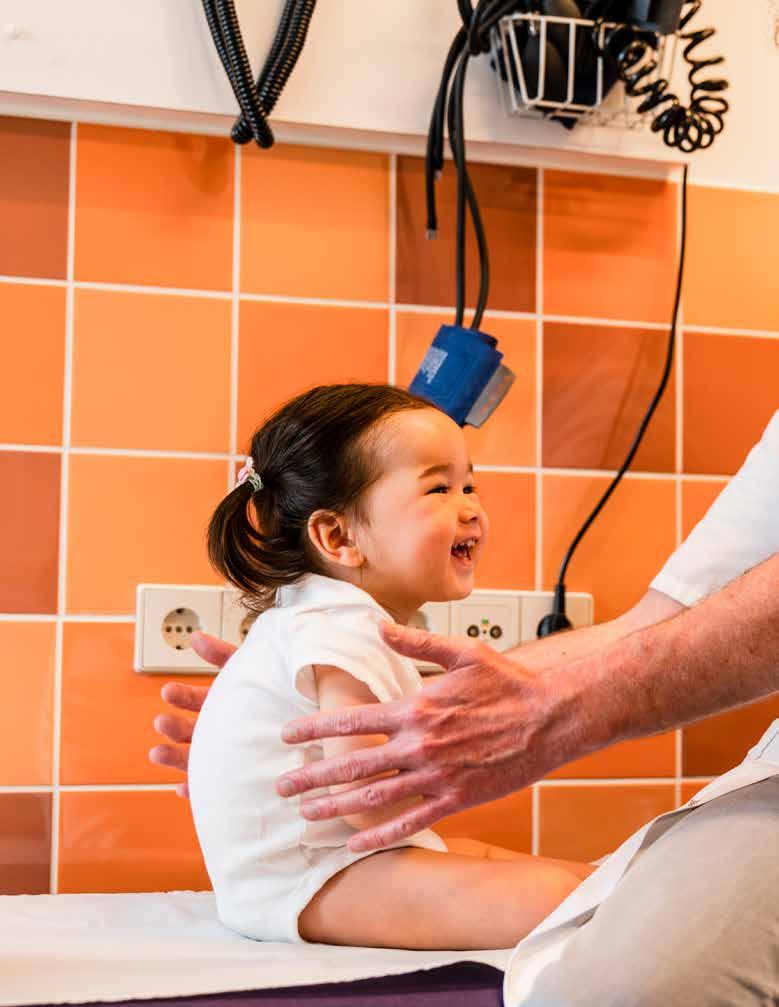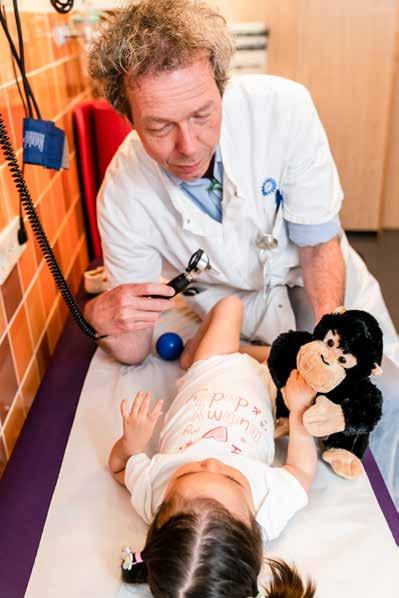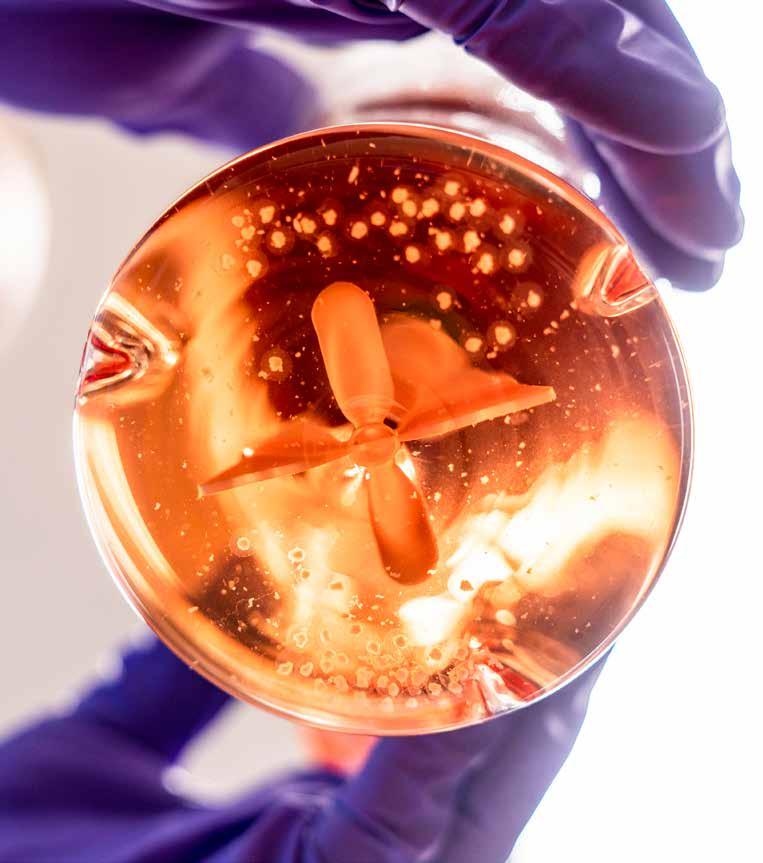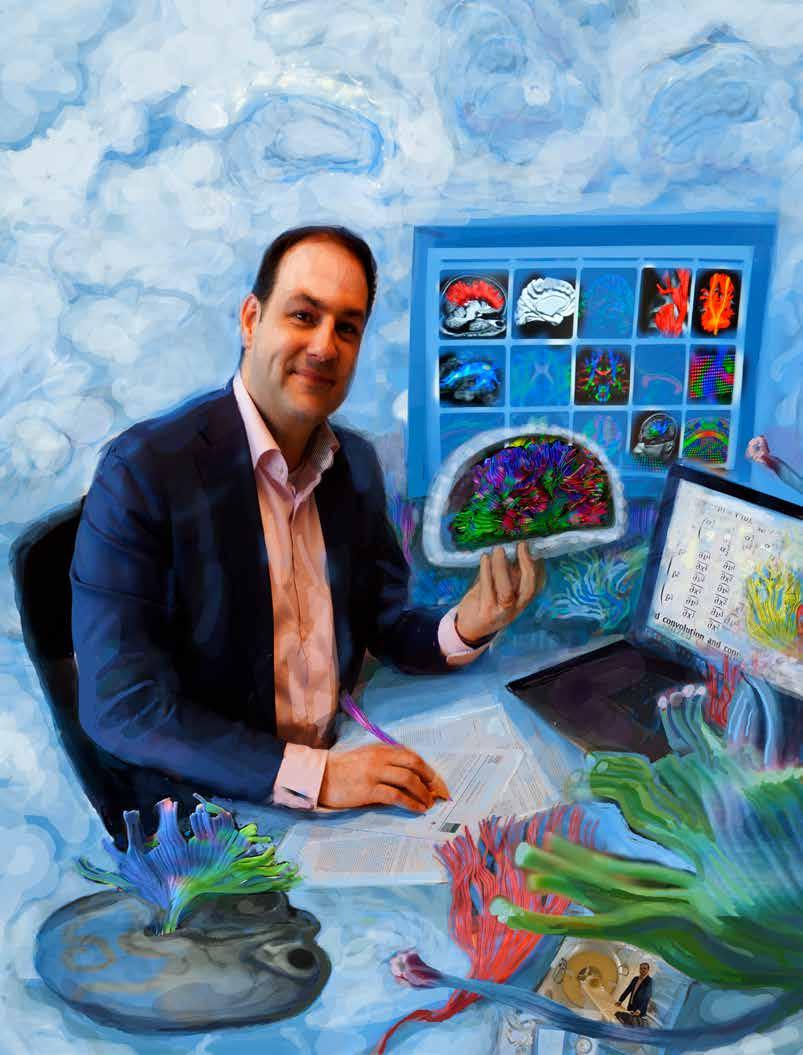
7 minute read
Interview
Interview with Ludo van der Pol
Advertisement
Ludo van der Pol has been working with SMA patients for eighteen years. They have a genetic disorder that causes their muscles to waste away and for which there is no cure. Until now.
By Bart Braun Images: Bram Belloni
‘I n severe cases of spinal muscular atrophy, or SMA, the mother knows something is wrong during the pregnancy. In the third trimester, the child’s movements decrease. Children with SMA are floppy babies: they are very weak. This is seen in combination with several neurological disorders, but SMA typically presents itself in a pattern: the babies are very much alert, combined with lack of movement. The child would appear to be normal at birth, and a few weeks later there would be no chance of survival. We doctors were unable to offer anything.
‘There are four different types of SMA. The earlier it presents itself, the more severe the symptoms. Type 1 is diagnosed in newborn babies. They will never be able to sit, and the majority will not live to see their third birthday. Children with type 2 will never learn to walk. Type 3 is considered the ‘mild’ form, but it is not really mild at all. Some patients can walk for dozens of years, others end up in wheelchairs at the age of twenty. Type 4, in which symptoms develop after the age of thirty, is relatively rare.
‘Patients with SMA lack the SMN1 gene that codes a protein known as SMN, which is needed in all sorts of cells. The classic story is that, without SMN, the nerve cells in your spinal cord that control your muscles, the so-called motor neurons, die off. Because your muscles are no longer being stimulated, they waste away. We now know that this protein also plays a role in the muscles themselves and that other tissue is also affected when there is no SMN. The cells of the heart, for example,

A normal school
Yuxia Jiang’s daughter Caroline has SMA. ‘A child with SMA demands a lot from you as a parent, both physically and mentally. Because of her muscle problems, Caroline isn’t able to do much by herself and I have to help her with everything. Mentally, it occupies your mind constantly. The course of the disease is difficult to predict, which causes a lot of worry. The future is not always something to which we look forward. I am very happy and grateful for the help from the hospital. The doctors and researchers show a great deal of compassion and try their very best to help us, to ensure that our daughter can go to a normal school when she is older. That really touches me. Caroline is now receiving full-time treatment with nusinersen. It helps her to lift up her arms and head, and she can even stand a bit with my help. We are always prepared to collaborate when researchers need our input. New drugs are already being developed, so we hope they will be available here soon. Despite everything, we try to remain positive, with all these new scientific developments.’
and the cells involved in your sugar metabolism. The cells in your motor nervous system are just the most sensitive, so their loss is the most noticeable.’
Course of the disease ‘If you genetically modify test animals and remove the SMN1 gene, the animals all die before birth. You cannot live without this protein. The reason that SMA patients are able to survive, initially, is that humans have a similar gene, SMN2. Because not everyone has an equal number of copies of this gene and not every copy of the gene results in the same amount of protein, the course of the disease varies greatly between patients.
‘Since December 2017, we are permitted to proscribe the drug nusinersen to SMA patients with type 1 and 2 and to some type-3 patients. In practice, the drug is now given almost exclusively to children aged five and below.
‘The active substance is a small bit of DNA-like material that affects the reduction of the SMN2 gene. It ensures that more SMN2 protein is created.
‘This injection doesn’t mean that a sick patient is transformed into a perfectly healthy child; there are no drugs like that for congenital defects. For babies it means survival. And motor development also improves: they can reach motor development milestones, like sitting. Their further development is still uncertain. In older children, we see that they learn to improve movement, for example an increase in arm function, and that there is no more deterioration of the things they were already able to do. It’s not a cure, but it is a giant step in the right direction. We can really make life a lot more enjoyable for these children.’
A real difference ‘Even more important is that this drug is a proof of concept: this type of medicine can be developed, and it works. There has been an enzyme-replacement drug for Pompe disease for the past twelve years, but nusinersen is the first comparable drug since then to really make a difference. Now a diagnosis no longer means the end of the line; we are able to do something.
‘At the moment, this drug is still very expensive. Patients will need it their entire lives. The debate concerning the maximum

price of medication is about limits and cost efficiency. It concerns not only this disorder, but it is something we will encounter with increasing frequency, because this is 21 st -century medicine. We as a society must determine what we want, and how we are going to inform each other.
‘Spinal muscular atrophy and cystic fibrosis are two genetic disorders that are relatively common – there are a few hundred SMA patients in the Netherlands and approximately 1500 people with cystic fibrosis. This means these two diseases will determine how we deal with the rest. On the bright side: because these are the two most common genetic disorders, they also make up the largest cost item.’
Patients’ stories ‘The Spieren voor Spieren [Muscles for Muscles] Children’s Center / SMA expertise center here at UMC Utrecht, of which I am the chairman, was set up in 2010. The parents of patients were complaining that it took too long for them to be put in contact with the right doctor, and the Spieren voor Spieren Foundation wanted there to be a specialized location for these patients. So, they ended up here in Utrecht. How did we get started? By seeing our young patients. That story about cells and genetics is very important and has now resulted in treatment, but to really understand the disease requires more of the patients’ stories. We were in a privileged position, because many people wanted to tell us their story. We also heard many things that were new to us.
‘For example, specialist literature on SMA ends at the age of 18. The interviews that we conducted showed us that deterioration continues into adulthood, even dramatically so. People become more and more dependent on others. When you end documentation at such an early age, you see teenagers who have lost the ability to walk but are still able to move themselves about in a wheelchair. But when you come across those same people in middle age, it’s shocking how invalid they have become.
‘First of all, research like this maps out the need for new therapies. And it shed light on another issue: muscles are one thing, but endurance is another. The problem is often that SMA patients are still able to hold a fork, but that they have to stop after two bites. In our research, we focus on what precisely happens and what can be done about it. We have just completed a study of a drug – an inexpensive drug that you can take like a pill – that could improve endurance.’
Fear ‘Research like this, based on patients’ requests, really contributes to what they want. It is extremely important to converse with people: what really matters to you? What problems do you come across? What could we do to make the sun shine a bit more for you? This dialogue takes place annually, with the help of the Princess Beatrix Fund for Muscle Disease. Many of our studies are set up this way. They cover chewing and food, but also psychological needs. How do people perceive you? How is your mood? Do you have many feelings of fear?
‘We consult with psychologists, physical therapists, speech therapists, and other people that you might not speak too very often as a neurologist. Too often patients visit just to please the doctor. These are situations in which the doctor looks back at a conversation and is satisfied, while the patient has the idea that he is leaving empty-handed. We try our best to do it the other way around.’









